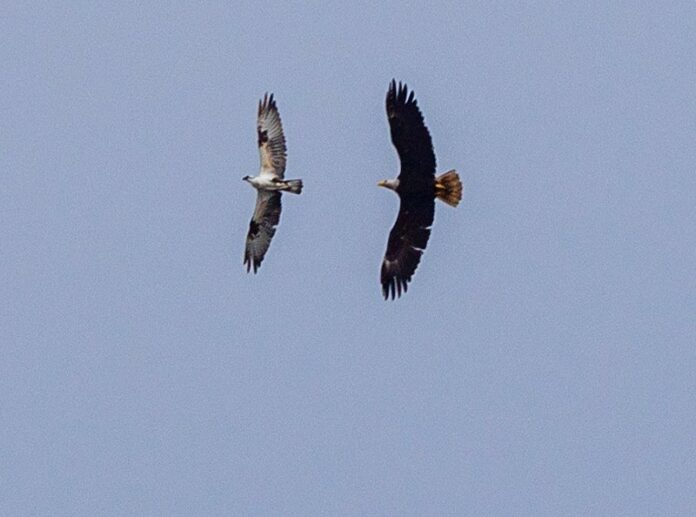The morning fog was receding on Tomales Bay as a Debriefer correspondent and companions put-in with their kayaks and headed for a remote camping spot.
Spotted within a half-mile of the journey: silvery flashes at the waterline, as a school of small fish leapt out of the water. Attentive seagulls swooped in. Another mile into the paddle: an osprey flew by near the western shore of Tomales Bay. It hovered about 20 feet above the water, pulled in its wings and dove in. It emerged with a nice-sized fish in its talons. But the osprey didn’t hold it for very long. Enter the bald eagle, a rare sight indeed in these parts—though that is becoming increasingly less so.
The enormous bird swooped in from behind and overtook the osprey, which dropped the fish amid much squawking and flapping of wings. The eagle caught the fish in midair, just before it hit the water, and gained altitude as it turned sharply toward shore.
Ospreys are very good fishermen, which helps explain their ubiquity; they’re found in temperate and tropical regions on all continents except Antarctica. The bald eagle, on the other hand, is unique to North America.
Both birds experienced endangering population decreases from the 1950s through the ’70s as a result of the pesticide DDT, which was used on crops. The resultant runoff, as described by Rachel Carson in Silent Spring, went to streams, creeks and rivers, where it was absorbed by the fish that osprey and eagles ate. The poison interfered with calcium metabolism in the birds, and resulted in thin-shelled eggs that broke easily. The birds’ populations plummeted.
According to the Center for Biological Diversity, in 1963 fewer than 500 mating pairs of bald eagles existed in the lower 48. When the eagle was adopted as the national bird in 1782, there were between 12,000 and 32,000 pairs, as estimated by the Smithsonian’s National Zoological Park.
In 1972, DDT was banned; the federal Endangered Species Act was enacted the following year, and the bald eagle has rebounded as a result. The Center for Biological Diversity estimates that there were more than 11,000 mating pairs of bald eagles in the lower 48 as of 2007.
There’s at least one eagle flying around Tomales Bay, and efforts to restore eagle-friendly habitats in the region have meant an uptick in sightings in recent years.
The 2009 completion of the Giacomini Wetlands Restoration Project at the southern end of Tomales Bay, resulted in a potential increase in habitat for bald eagles. “We’ve had a significant increase in bald eagle sightings here over the last five years,” says John Dell’Osso, chief of interpretation and resource education at Point Reyes National Seashore. Dell’Osso says he often sees a bald eagle at the Nicasio Reservoir on his commute to work.
Want to see one? Try the mouth of the Russian River near Penny Island, and Lake Sonoma, Laguna de Santa Rosa, Estero Americana and, of course, Tomales Bay.











